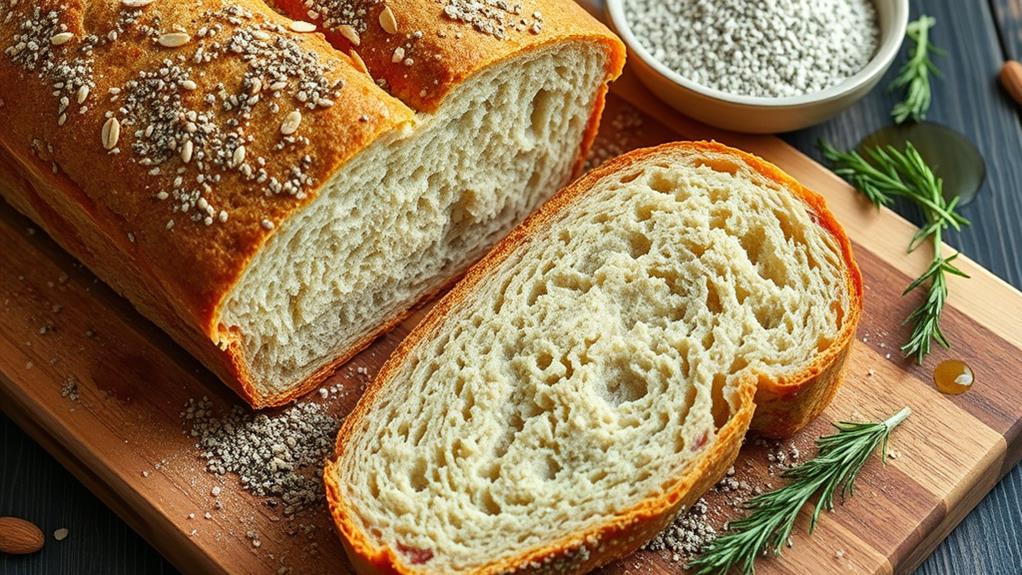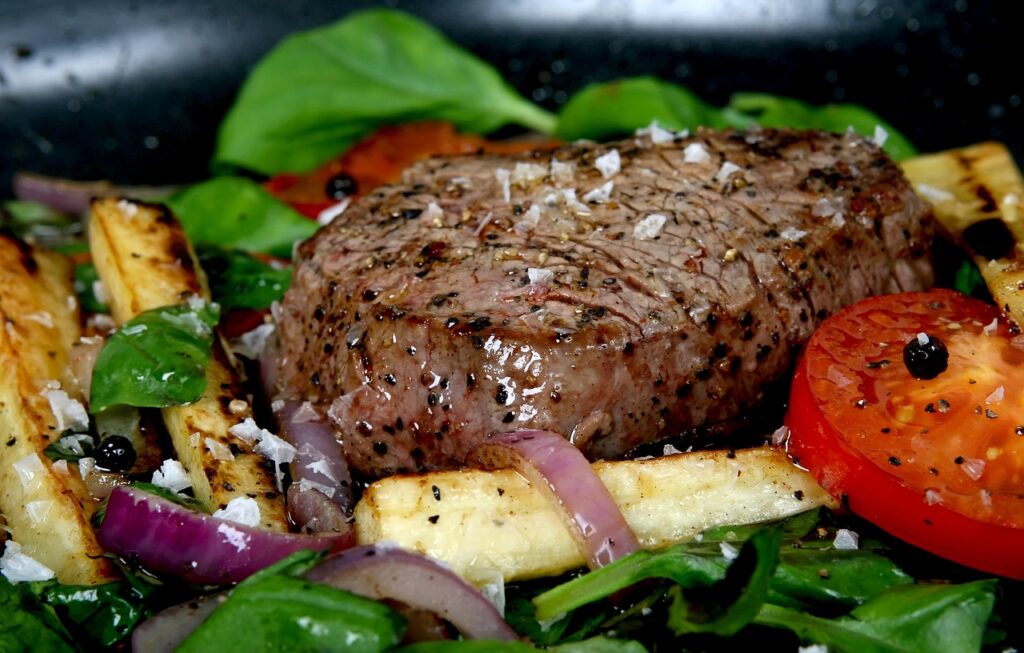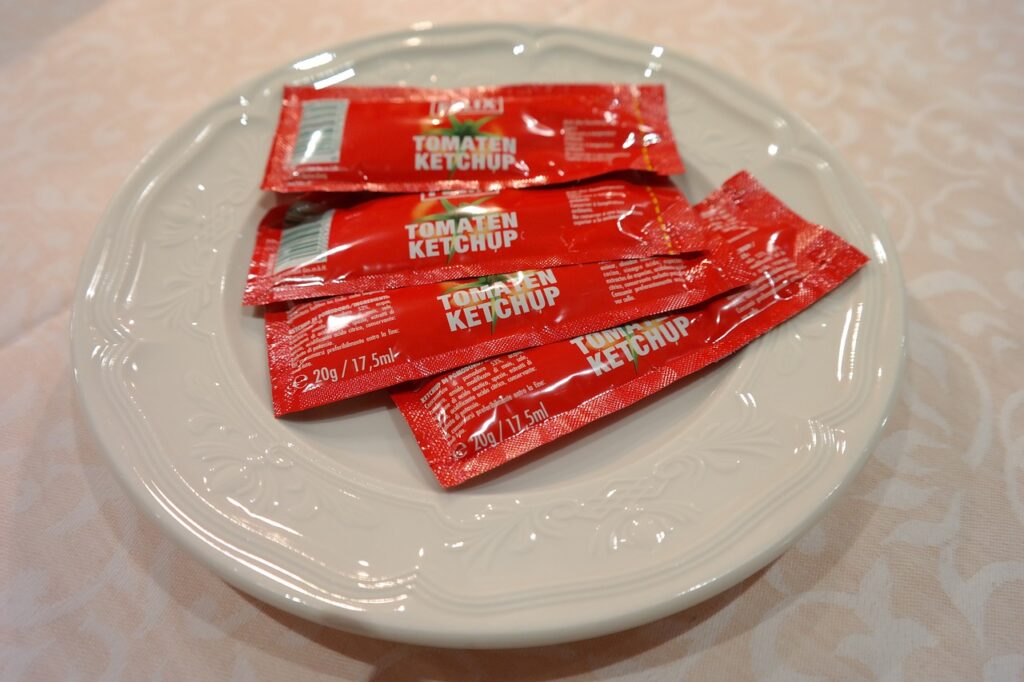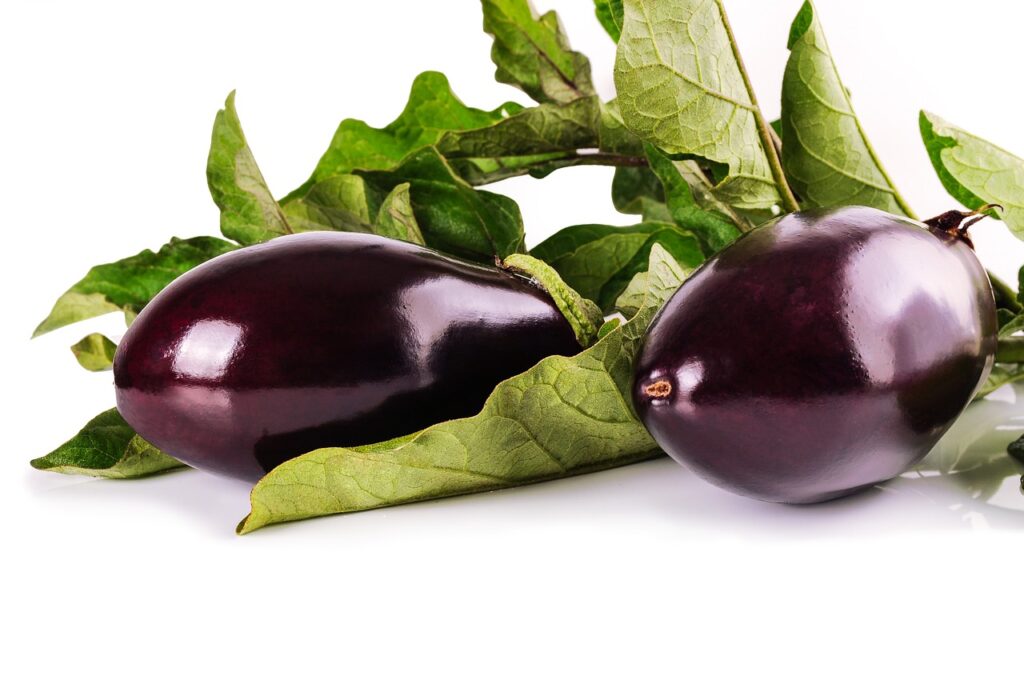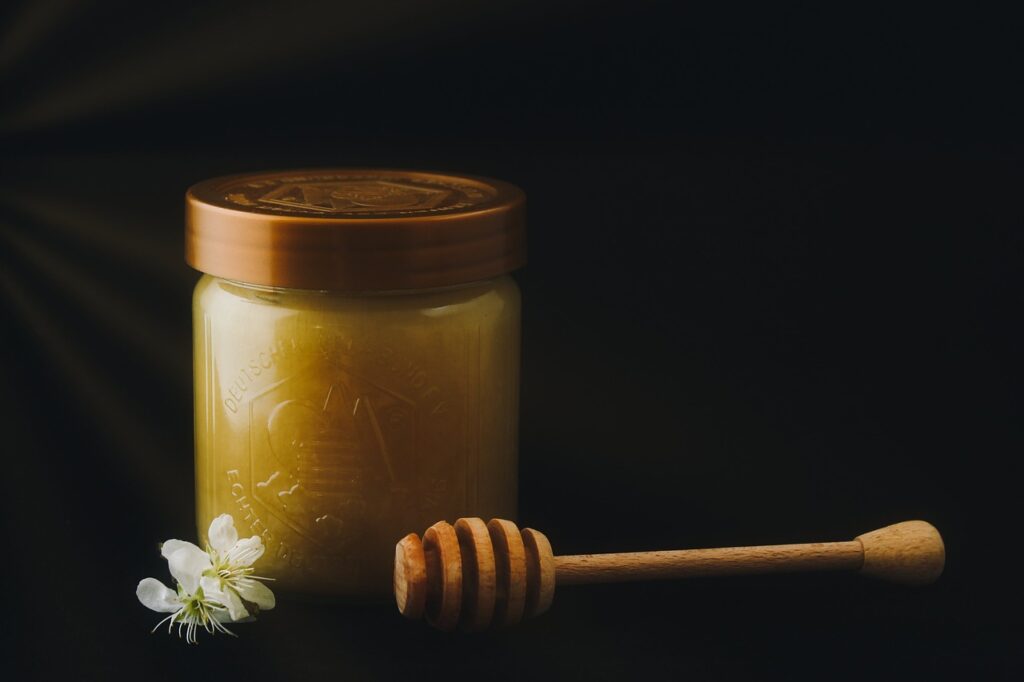Keto bread is gluten-free because it's made from alternative flours like almond and coconut, rather than traditional wheat. This choice eliminates gluten, making it safe for people with gluten sensitivities or celiac disease. The low-carb nature of these flours fits perfectly into the keto diet, keeping your net carbs low while providing healthy fats and proteins. Plus, ingredients like psyllium husk and flaxseed meal enhance its texture and nutritional value. If you're curious about how these ingredients work together or what else to look for in keto bread, there's more to explore on the topic.
Understanding the Keto Diet
When diving into the keto diet, you'll quickly discover its core principle: drastically reducing carbohydrate intake. Typically, this means limiting your daily carbs to just 20-50 grams. By doing this, you enter a state called ketosis, where your body shifts from burning glucose to burning fat for fuel.
The macronutrient ratio for a standard keto diet usually consists of around 70-80% fats, 5-10% carbohydrates, and 10-20% protein, emphasizing high-fat, low-carb options. To support this, many people incorporate top low-carb flour alternatives into their recipes. These flours offer unique flavors and baking properties while keeping the carbohydrate count low.
To adhere to these guidelines, you'll want to avoid grains and sugars, which can spike insulin levels and kick you out of ketosis. Instead, you'll find that keto-friendly bread provides gluten-free options that substitute traditional wheat with low-carb flours like almond flour, coconut flour, or flaxseed meal.
These alternatives help you enjoy the texture of bread without compromising your dietary goals.
What Is Gluten-Free Bread?
Gluten-free bread is crafted without any gluten-containing grains, making it a safe choice for those with gluten intolerance or celiac disease. Instead of wheat, barley, or rye, this type of bread uses alternative flours like almond flour, coconut flour, or rice flour. These substitutions are vital for avoiding adverse health reactions.
Incorporating healthy fats, such as coconut oil, can enhance the nutritional profile of gluten-free bread while providing additional moisture and flavor. When you choose gluten-free bread, you'll notice that it often includes a variety of flours, such as cassava, amaranth, or tapioca. Each flour has its own nutritional profile, which can differ considerably from traditional wheat flour.
To improve the texture and mimic the elasticity typically provided by gluten, manufacturers often add ingredients like psyllium husk or xanthan gum.
If you're mindful of your carbohydrate intake, it's important to check the labels. Gluten-free bread usually contains between 11 to 21 grams of carbs per slice. For those on a low-carb diet, understanding these values can help you make better choices.
Whether you're baking at home or buying from a store, gluten-free bread offers a versatile option that accommodates your dietary needs while still satisfying your cravings.
Key Ingredients in Keto Bread
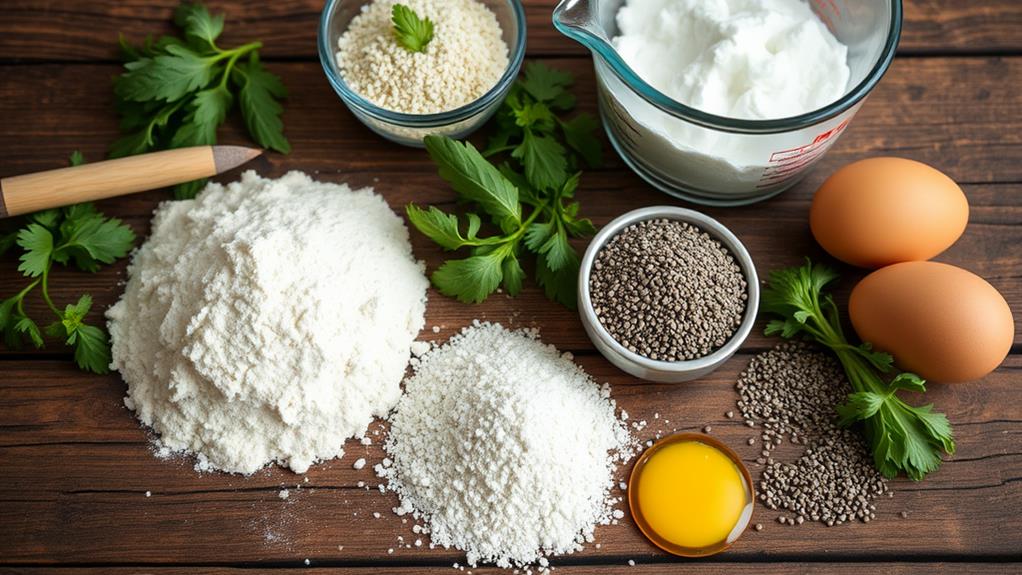
When you're making keto bread, the choice of flour is vital, and you'll often find almond or coconut flour as popular options.
Almond flour, in particular, isn't only low in carbohydrates but also provides low carb benefits and healthy fats, making it an ideal choice for keto enthusiasts.
These flours not only keep your bread gluten-free but also offer nutritional benefits like lower carbs and added fiber.
Plus, incorporating seeds and egg-based ingredients can enhance both the texture and the protein content of your bread.
Common Keto Flours Used
Keto bread relies on a variety of flours that keep it low in carbs while still delivering great taste and texture. One of the most common options is almond flour, which is low in carbohydrates and high in healthy fats. This makes it a favorite for anyone following a keto diet.
Coconut flour is another essential ingredient; it boasts high fiber content and excellent moisture absorption, ensuring your bread retains a satisfying texture.
You might also encounter psyllium husk powder in many keto bread recipes. This ingredient serves as a binding agent, improving the bread's structure and providing that desirable chewiness without any gluten. Additionally, flaxseed meal is often included for its omega-3 fatty acids and extra fiber, enhancing the nutritional profile of your bread.
While almond and coconut flours are staples, other alternatives like sunflower seed flour and lupin flour can be used as well. These options cater to various dietary restrictions, allowing you to enjoy delicious, gluten-free bread without compromising on taste or texture.
With these flours, you can create a keto bread that meets your dietary needs while satisfying your cravings.
Nutritional Benefits Overview
Bread lovers can rejoice, as keto bread offers a delicious way to enjoy a low-carb lifestyle without sacrificing nutrition. This gluten-free option is primarily made from almond and coconut flour, providing a low-carb alternative to traditional wheat flour. With fewer than 5 net carbs per slice, keto bread fits perfectly into your ketogenic diet while accommodating gluten-free dietary needs.
One of the standout nutritional benefits of keto bread comes from its key ingredients. Psyllium husk powder boosts fiber content, supporting your digestive health and enhancing the texture of the bread without using gluten.
Additionally, many recipes include high-quality proteins from eggs, which are essential for muscle maintenance and help you feel fuller for longer. Healthy fats, like almond butter, are also prevalent in keto bread, ensuring you meet your high-fat dietary requirements while gaining essential nutrients.
These ingredients combine to create a satisfying bread option that doesn't compromise on taste or health. So, if you're looking for a nutritious way to enjoy bread while sticking to your keto and gluten-free goals, keto bread is a fantastic choice!
Gluten-Free Ingredient Sources
Many delicious options exist for creating gluten-free keto bread, thanks to a variety of alternative flours and ingredients. One of the most popular choices is almond flour. It's rich in healthy fats and protein while being low in carbohydrates, making it an ideal fit for your keto lifestyle.
You'll find that almond flour not only adds a nutty flavor but also helps create a satisfying texture in your bread.
Another excellent gluten-free option is coconut flour. This flour is high in fiber and low in net carbs, which contributes to the overall nutritional profile of your keto bread.
Keep in mind that coconut flour absorbs a lot of moisture, so you might need to adjust your liquid ingredients accordingly.
You can also enhance the texture of your keto bread by adding psyllium husk powder. It provides additional fiber and helps hold the bread together, ensuring it doesn't crumble easily.
Carbohydrate Content Explained
When you're considering keto bread, understanding net carbs is essential for staying within your carb limits.
The ingredients you choose, like almond or coconut flour, greatly affect the overall carbohydrate content compared to traditional bread.
For example, almond flour isn't only low in carbs but also nutrient-dense, providing healthy fats and protein, making it an excellent choice for keto baking.
Net Carbs Calculation
Understanding net carbs is vital for anyone maneuvering a ketogenic diet, especially when it comes to choosing gluten-free options. When evaluating keto bread, you'll want to focus on the net carbs per slice. These breads are typically made with low-carb flours like almond flour, coconut flour, or flaxseed meal, which greatly lower their carbohydrate content compared to traditional wheat bread.
To calculate net carbs, simply subtract dietary fiber and sugar alcohols from the total carbohydrates. This method gives you a clearer picture of how carbs affect your blood sugar. Most keto breads contain only 1-5 net carbs per slice, making them an excellent fit for those adhering to gluten-free diets while staying within their carb limits.
For instance, Carbonaut Gluten Free Bread boasts just 1g of net carbs per slice, showcasing its compatibility with both keto and gluten-free lifestyles.
When choosing keto bread, always read the labels carefully. Net carb counts can vary widely between brands and products, so making informed choices is important for your dietary success.
Ingredient Impact on Carbs
The ingredients in keto bread play an essential role in determining its carbohydrate content. Unlike traditional wheat-based bread, which can pack around 14 grams of carbs per slice, keto bread often features low-carb ingredients like almond flour, coconut flour, and flaxseed meal. These alternatives greatly reduce the carb count, allowing many keto breads to contain just 1-5 net carbs per slice.
When you subtract dietary fiber from total carbs, you see how these ingredients contribute to a gluten-free option that fits within low-carb diets. Additionally, ingredients like psyllium husk and eggs not only enhance the texture of keto bread but also provide necessary binding without adding considerable carbs.
This unique combination of ingredients guarantees that you enjoy a satisfying bread experience without the excess carbohydrates found in traditional varieties. The absence of wheat and grains is what makes keto bread gluten-free, catering to those with gluten sensitivities.
Comparing Bread Varieties
Keto bread stands out among various bread types due to its remarkably lower carbohydrate content. If you're following keto diets, you'll appreciate that keto bread typically contains just 1 to 5 net carbs per slice. This is a stark contrast to many gluten-free breads, which often range from 11 to 21 grams of carbs per slice, making them less suitable for your low carb lifestyle.
While most gluten-free breads are high in carbs, some keto-friendly options, like Carbonaut bread, are specifically designed to fit both gluten-free and keto diets with only 1 gram of net carbs per slice. This makes them an excellent choice for those who need to avoid gluten but still want to keep their carb intake low.
Keto bread uses alternative flours like almond or coconut flour and ingredients like psyllium husk and eggs, which provide structure and texture without gluten.
However, it's essential to read labels carefully, as some gluten-free breads can be deceptively high in carbs. By choosing the right products, you can enjoy delicious bread while staying true to your keto and gluten-free needs.
Health Benefits of Keto Bread
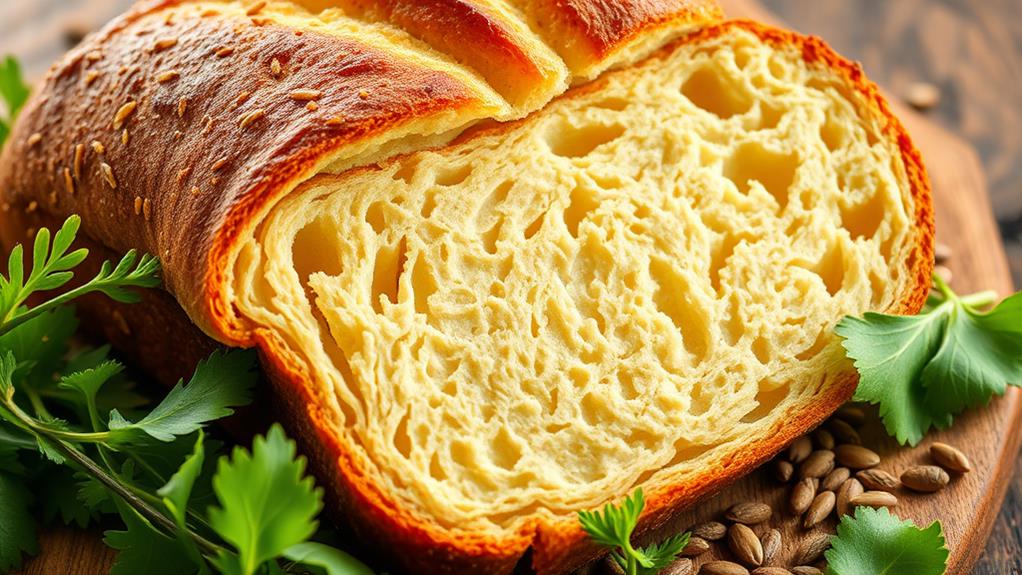
Many people are discovering the health benefits of keto bread, which is often crafted from gluten-free ingredients like almond flour and coconut flour. This makes it a fantastic choice for those who are gluten intolerant or have celiac disease.
Plus, it's keto friendly, allowing you to enjoy bread without the high carb content of traditional options. Additionally, incorporating eggs into your keto meals can enhance the overall nutritional profile, as they're low in carbs and high in quality protein, providing essential vitamins and nutrients the nutritional benefits of eggs.
Here are three key health benefits of keto bread:
- Supports Weight Loss: With only 1-5 net carbs per slice, keto bread fits seamlessly into a low-carb diet, helping you shed those extra pounds.
- Promotes Satiety: The higher protein content found in keto bread keeps you full longer, which is essential during weight loss efforts.
- Aids Digestion: Many keto bread options are high in fiber, promoting healthy digestion and a well-functioning gut.
Popular Keto Bread Brands
Finding the right keto bread can make all the difference in maintaining your low-carb lifestyle. With brands like Franz Bakery, you can explore a variety of low-carb options that satisfy your cravings without sacrificing flavor. Many of these breads are made with keto-friendly dairy products, enhancing their taste and texture.
SoLo Carb also offers delicious varieties like Harvest Wheat and Country White, each containing just 3 net carbs per slice. If you want something even lower in carbs, consider Carbonaut Gluten Free Bread. It's keto-certified and boasts only 1g of net carbs per slice, making it perfect for those avoiding gluten while sticking to a low-carb diet.
ThinSlim Foods and Base Culture are other notable brands providing gluten-free bread alternatives that meet keto dietary needs. These brands typically use gluten-free ingredients like almond flour and coconut flour, helping them maintain a bakery-quality texture while keeping the carbohydrate content low.
When choosing your keto bread, remember that not all options are gluten-free. Some brands, such as SoLo Carb, may contain gluten, so it's essential to stay informed. With the right choices, you can enjoy delicious, keto-friendly bread that fits seamlessly into your diet.
Reading Labels for Keto Bread
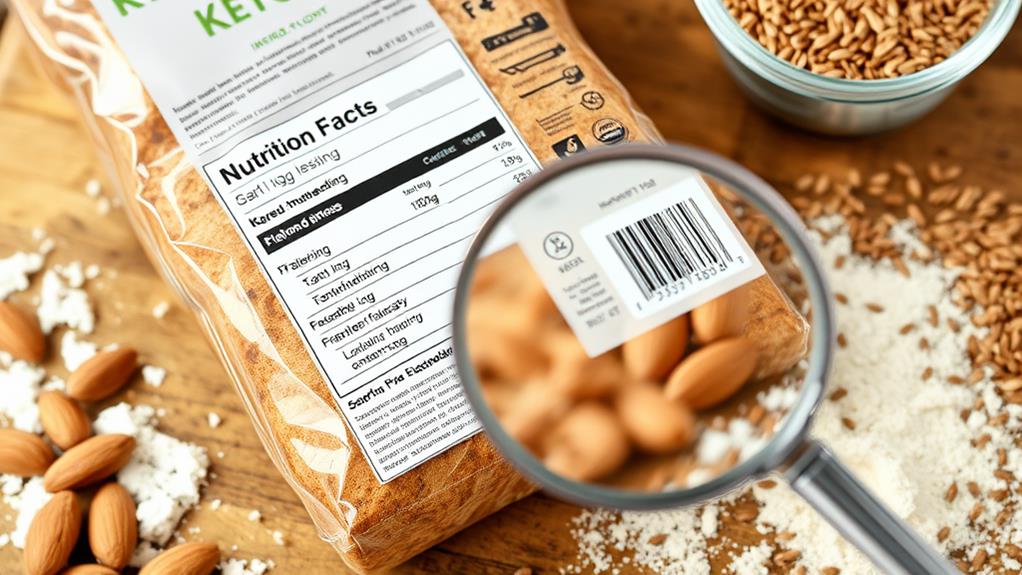
Choosing the right keto bread requires careful attention to labels. Not all keto breads are created equal, especially when it comes to being gluten-free. The Keto diet, known for its emphasis on healthy fats and low carbohydrate intake, also encourages the use of alternative flours that are typically gluten-free.
Here's what you should focus on:
- Gluten-Free Certifications: Always look for gluten-free labels or statements. This guarantees the bread is safe for your dietary needs.
- Ingredient Lists: Check for alternative flours like almond, coconut, or flaxseed. These are commonly used in gluten-free keto breads and are better than wheat, barley, or rye.
- Nutritional Profiles: Pay close attention to the total carbohydrate content and net carbs. Subtract dietary fiber and sugar alcohols from total carbs to see if it fits within your keto limits.
Also, be mindful of potential allergens listed on the packaging. Some keto breads may contain nuts or eggs that could trigger sensitivities.
Finally, don't hesitate to compare different brands and varieties, as their nutritional profiles can vary greatly. By being diligent in reading labels, you'll guarantee you're making choices that align with your keto diet and gluten-free lifestyle.
Additionally, maintaining a balanced diet with healthy fats can support your overall wellness, including improved cholesterol levels.
Homemade Keto Bread Recipes
Making your own keto bread can be a rewarding experience, allowing you to control the ingredients and customize flavors to your liking. One of the most popular low-carb flours for homemade keto bread is almond flour, which isn't only gluten-free but also adds a delightful nutty flavor.
In many recipes, you'll find eggs, which provide essential structure and moisture, along with baking powder or soda for leavening, ensuring a fluffy texture. To enhance the bread's consistency, consider adding psyllium husk powder, which mimics the elasticity usually provided by gluten.
A favorite among keto enthusiasts is fathead dough, combining mozzarella cheese, cream cheese, and almond flour. This versatile base allows you to create various types of gluten-free bread, from rolls to pizza crusts.
As you experiment with your homemade keto bread, keep an eye on the net carb content. Most recipes yield between 1 to 5 net carbs per slice, making them a perfect fit for your keto diet.
Comparing Keto and Traditional Bread
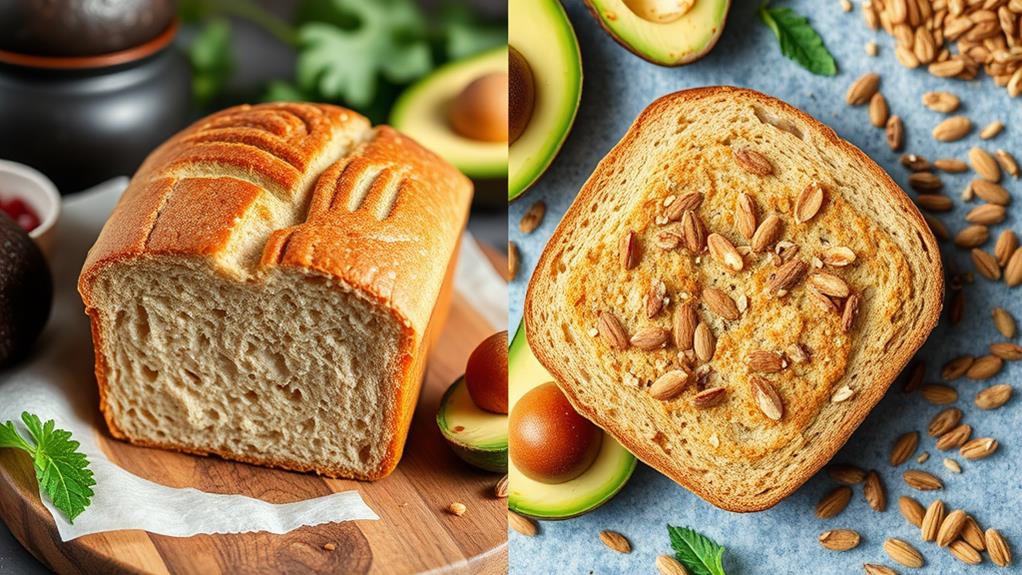
When you compare keto and traditional bread, the differences in carb content are striking.
While traditional bread can pack in 15 to 30 grams of carbs per slice, keto bread keeps it low with just 1 to 5 net carbs.
Plus, the ingredients used in each type highlight their unique dietary goals, with keto bread focusing on healthier, low-carb alternatives.
Carb Content Comparison
A significant difference between keto bread and traditional bread lies in their carb content. If you're looking to maintain a low-carb lifestyle, you'll quickly notice that keto bread is a much better fit.
Here's how they compare:
- Net Carbs: Keto bread typically contains only 1-5 net carbs per slice, while traditional bread usually has around 14-21 grams of carbs per slice.
- Ingredients: Traditional bread often uses wheat flour, which is high in carbohydrates. In contrast, keto bread relies on low-carb ingredients like almond flour or coconut flour.
- Protein Levels: Traditional bread contains about 3.1 grams of protein per slice, whereas keto bread often provides higher protein levels, which can help you feel fuller for longer.
Moreover, gluten-free options are readily available in the keto bread category. This makes it suitable for those with gluten intolerance, allowing you to enjoy bread without compromising your dietary needs.
Ingredient Differences Explained
Keto bread stands apart from traditional bread primarily due to its unique selection of ingredients. Instead of using wheat flour, which contains gluten, you'll find alternatives like almond flour, coconut flour, or flaxseed meal in keto recipes. These options not only cater to those following a gluten-free diet but also considerably lower the carbohydrate content.
Unlike traditional bread, which relies on gluten for structure and texture, keto bread often includes binding agents such as xanthan gum or psyllium husk. These ingredients help achieve the desired consistency and prevent crumbling, ensuring your bread holds together beautifully.
Moreover, many keto bread recipes emphasize high-fat ingredients like eggs and cheese, promoting a nutritious profile without the need for gluten. In contrast, traditional bread often includes added sugars and preservatives, which keto bread avoids by focusing on low-carb and clean ingredients.
Tips for Choosing Keto Bread
Choosing the right keto bread can make a significant difference in your low-carb journey. To guarantee you pick a healthy option, keep these tips in mind:
- Look for gluten-free labels: Not all keto bread is free from gluten-containing ingredients. Always check the packaging to confirm it's gluten-free.
- Check the net carbs: Aim for breads with 1-5 net carbs per slice. This helps you maintain ketosis while keeping your carb intake low.
- Opt for alternative flours: Choose breads made with almond flour or coconut flour. These are both low in carbs and gluten-free, making them healthier options for your diet.
Additionally, be cautious of added ingredients. Some keto breads may contain inflammatory oils or preservatives, so prioritize those with clean, recognizable ingredients.
Also, consider the fiber content; breads high in fiber can aid digestion and support your overall health while on a low-carb diet.
Conclusion
In the world of keto, swapping traditional bread for gluten-free options can be a game-changer for your diet. Remember, "you are what you eat," so choosing the right bread makes a difference in your health journey. By understanding the key ingredients and benefits of keto bread, you can enjoy delicious meals without sacrificing your goals. Whether you buy or make your own, embracing keto bread can keep you on track and satisfied. Happy baking!

